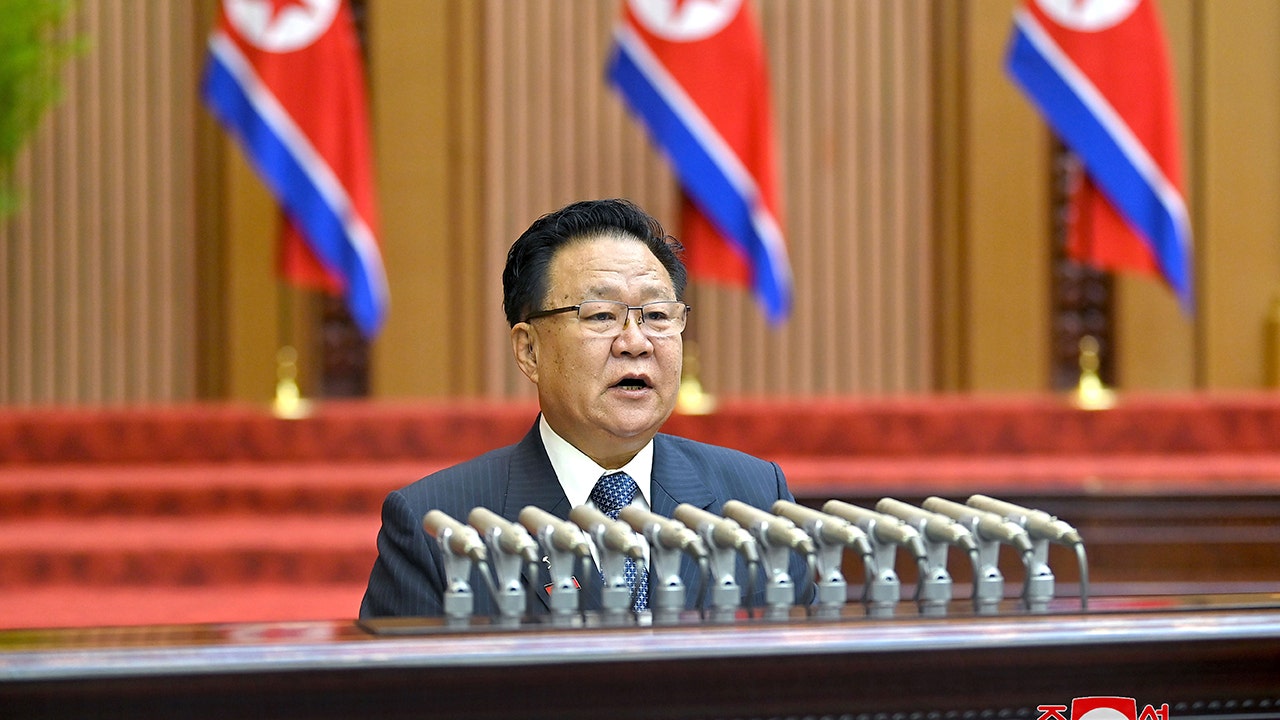World
North Korea vows to block border with South Korea and build front-line defense structures

North Korea said Wednesday it will permanently block its border with South Korea and build front-line defense structures to cope with “confrontational hysteria” by South Korean and U.S. forces, while not announcing an expected constitutional revision to formally designate South Korea its principal enemy and codify new national borders.
NORTH KOREAN TROOPS NOW FIGHTING FOR RUSSIA IN UKRAINE, SEOUL SAYS
While the moves were likely a pressure tactic, it’s unclear how they will affect ties with South Korea since cross-border travel and exchanges have been halted for years.
North Korea’s military said it will “completely cut off roads and railways ” linked to South Korea and “fortify the relevant areas of our side with strong defense structures,” according to the North’s official Korean Central News Agency.
The North’s military called its steps a “self-defensive measure for inhibiting war and defending the security” of North Korea. It said that “the hostile forces are getting ever more reckless in their confrontational hysteria.” It cited what it called various war exercises in South Korea, the deployment of U.S. strategic assets and its rivals’ harsh rhetoric.
In this photo provided Wednesday, Oct. 9, 2024, by the North Korean government, Choe Ryong Hae, the chairman of the Assembly’s Standing Committee, speaks during the Supreme People’s Assembly in Pyongyang, North Korea. (Korean Central News Agency/Korea News Service via AP)
South Korea’s military said later Wednesday that it won’t tolerate any attempt by North Korea to change the status quo. It said South Korea will “overwhelmingly punish” North Korea if it launches provocations. A South Korean military statement said North Korea’s nuclear and missile programs have threatened peace on the Korean Peninsula.
South Korean officials earlier said North Korea had already been adding anti-tank barriers and reinforcing roads on its side of the border since April in a likely attempt to boost its front-line security posture and prevent its soldiers and citizens from defecting to South Korea. In a report to parliament on Tuesday, South Korea’s Unification Ministry said that North Korea has been removing ties on the northern side of cross-border railways and nearby lamps and planting mines along the border.
KCNA earlier Wednesday said the Supreme People’s Assembly met for two days this week to amend the legal ages of North Koreans for working and participating in elections. But it didn’t say whether the meeting dealt with leader Kim Jong Un’s order in January to rewrite the constitution to remove the goal of a peaceful Korean unification, formally designate South Korea as the country’s “invariable principal enemy” and define the North’s sovereign, territorial sphere.
At the center of outside attention was whether North Korea makes new legal claims on the waters currently controlled by South Korea off their west coast. The poorly marked western sea boundary is where three bloody naval skirmishes and two deadly attacks blamed on North Korea happened in the past 25 years.
Some experts say North Korea might have delayed the constitutional revision but others speculated it amended the constitution without announcing it because of its sensitivity.
Kim’s order stunned many North Korea watchers because it was seen as breaking away with his predecessors’ long-cherished dreams of achieving a unified Korea on the North’s terms. Experts say Kim likely aims to diminish South Korea’s voice in the regional nuclear standoff and seek direct dealings with the U.S. They say Kim also likely hopes to diminish South Korean cultural influence and bolster his rule at home.
Tensions on the Korean Peninsula are at their highest point in years, with North Korea continuing a run of provocative weapons tests and South Korea and the U.S. expanding their military drills. KCNA said North Korea on Tuesday tested a long-range artillery system that observers say pose a direct threat to Seoul, the South Korean capital, which is only an hour’s drive from the border.

World
Fox News Proposes Dates for Possible Second Trump-Harris Debate
World
Orbán's main foe Magyar talks corruption, Ukraine and government fight

“Building a new country step by step, brick by brick, and to bring back our country and to build a new European, peaceful and liveable modern Hungary. That’s our motto, and that’s our plan,” Hungary’s rising political star, Péter Magyar, told Euronews in an exclusive interview.
In this podcast, Radio Schuman interviews Péter Magyar, leader of the Tisza party in Hungary, who has recently emerged as the only popular alternative to Prime Minister Viktor Orbán.
Magyar spoke to Euronews political reporter Vincenzo Genovese in his office in Strasbourg, where the Hungarian MEP talked frankly about Orbán’s media machine, his own court cases in Hungary and where he stands on Ukraine, migration, and relations with China.
As the plenary session in Strasbourg wraps up later today, all eyes go to Luxembourg. On Thursday’s agenda, EU justice ministers will meet in Luxembourg to discuss Schengen, migration and asylum policies for the first time since Germany reintroduced land border controls for six months in a bid to tackle “irregular migration”.
Justice ministers will also discuss the controversial EU regulation aimed at detecting online child sexual abuse material. Despite this being a top priority for Hungary’s Council presidency, don’t expect a vote just yet — several EU diplomats say that a consensus among member states is still a long way off.
And here’s a little teaser: the 2025 World University Rankings are out. Think you know which European universities topped the list? Don’t be so sure. We don’t want to spoil the whole list for you, but we can tell you that European universities have seen a decline in this year’s ranking.
Check out the full story at euronews.com.
Radio Schuman is hosted and produced by Maïa de la Baume, with journalist and production assistant Paula Soler, audio editing by Zacharia Vigneron and music by Alexandre Jas.
World
Gaza in Ruins After a Year of War

One year ago, Gaza became a battlefield as Israel began a military offensive to root out Hamas in response to the Oct 7. Hamas-led attacks. The war has left Gaza unrecognizable. Tens of thousands of people have been killed, and almost everyone living there has been displaced — many of them multiple times.
Nearly 60 percent of buildings have been damaged or destroyed in the besieged enclave, an area about half the size of New York City. Videos and images from before and after the war started in some of the hardest hit areas — including Khan Younis, Gaza City and Jabaliya — reveal the magnitude of ruin across the strip.
Israel says its goal was to eradicate Hamas and destroy the tunnel network it built below ground. But in that attempt, it laid waste to an area that is home to some two million people.
54% of buildings have been likely damaged or destroyed.
In Gaza’s south is the governorate of Khan Younis, stretching from its eponymous medieval city, where the citadel wall stands as its historic anchor, to the lush fields that families have tilled for generations.
Now, the people of Khan Younis say they feel unmoored from time and place: The square where they played, prayed and gossiped is a ghost town. The farms that once nourished them have been bulldozed and pounded by Israeli artillery.
Israel says such strikes are necessary to attack Hamas militants and weapons hidden in hospitals, mosques, schools and other civilian areas. International law experts say Israel still has a responsibility to protect civilians even if Hamas exploits them.
Within the city of Khan Younis, only one citadel wall remains of its Mamluk-era fortress, ground away by centuries and wars past. It is the city’s lodestone.
That wall has lent its name to everything from the nearby marketplace to a space locals called “Citadel Square.” Here, vendors set up stalls to hawk goods and sugary concoctions and friends gathered around hookah pipes. A young oud player nicknamed Abu Kayan came during Eid holidays to strum Palestinian folk songs.
Citadel Square, Khan Younis
Before
Mamdouh Aljbour via Facebook
It was a humble outing even the most impoverished Gazan could enjoy, with a view of the citadel wall and the Grand Mosque on either side.
“What made it cool was that all kinds of people met there,” said Abu Kayan, 22, whose real name is Ahmed Abu-Hasaneen. “It was a place you could feel the spirit of our ancestors. It was a place we could hold on to and preserve.”
Now, the citadel wall looks out over a wasteland of rubble.
“I don’t think this place could be rebuilt,” said Abu Kayan. “Even if it could, nothing can replace the many friends I met there who have been killed, displaced, or fled abroad.”
Citadel Square, Khan Younis
After
Towering over the other side of the square was the 96-year-old Grand Mosque — the place to go for Friday prayers and staying up late into the night with family during the Muslim holy fasting month of Ramadan.
“That mosque was like the city’s address — the symbol of Khan Younis,” said Belal Barbakh, 25, who once volunteered to clean its carpets and perfume the halls before holidays.
That address no longer exists — Israel’s military said it struck the mosque to destroy Hamas infrastructure inside it, information The Times could not independently verify.
These days, Mr. Barbakh continues that ritual of cleaning and perfuming in the small plastic tent erected as a prayer hall at the foot of the pile of rubble that is all that remains of the Grand Mosque.
Buildings near Citadel Square
Beyond the mosque was the citadel’s commercial district, where playful hearts, young and old, sought out Hamada Ice Cream and the balloon-festooned Citadel of Toys.
Sisters Asan and Elan al-Farra, 16 and 14, remember birthday parties at Hamada, and the excitement they felt when their parents let them stop there after shopping.
Ice cream shop, Khan Younis
Before
Mamdouh Aljbour via Facebook
Passing by what is left of Hamada now, Elan said, is like watching the color drained out of her childhood: “It’s depressing seeing a place that was so bright end up black, battered, and dirty.”
Ice cream shop, Khan Younis
After
Just a few meters away are the pancaked floors of the building once home to the Barbakh brothers and their families — and their Citadel of Toys.
Abdulraouf Barbakh opened the toy store on the ground floor, indulging a childhood obsession with “any and all toys.”
During Eid celebrations, he welcomed a parade of children who marched in, clutching the holiday money their relatives had given them, eager to buy a long coveted doll, ball or water gun.
“I loved to see that smile of pure joy on children’s faces, especially for a people like ours that have suffered so much,” he said.
Toy store, Khan Younis
Before
Mamdouh Aljbour via Facebook
War has razed the Barbakh building to the ground, and the siblings and cousins who lived there are scattered.
Toy store, Khan Younis
After
Outside the remnants of their family building, Mr. Barbakh’s nieces and nephews sometimes linger, looking for signs of toys that survived beneath the ruins.
Mr. Barbakh cannot imagine going back to being a purveyor of joy to children.
“My only wish is to rescue my family from this war,” he said. “I have no plans to buy any more toys.”
The verdant Khuza’a region of Khan Younis, the breadbasket of southern Gaza, is land Jamal Subuh’s family has plowed for over a century. His children still remember their first time helping their father with the harvest, and the taste of the melons, tomatoes and peas they had picked fresh off the vine.
Mr. Subuh shared an image of what his cropland looked like before the war.
Subuh family land, Khan Younis
Before
Gaza’s farmlands represented a rare source of self-sufficiency in an area that has endured a decades-long blockade by Israel and Egypt.
“From generation to generation, we handed down a love of farming this land,” said Mr. Subuh, who was ordered off his property by Israeli military officials. “We eat from it, make money from it and feed the rest of our people from it.”
For Mr. Subuh, his fields were a chance to leave the next generation better off than his own: Each year, he farmed more lands, to pay for his son’s veterinary school and his daughter’s agricultural engineering degree.
He estimates that miles upon miles of fields have been bulldozed, his crops crushed. Advancing Israeli troops destroyed hundreds of thousands of dollars’ worth of tractors, water pumps and other equipment. The image provided here is the closest Mr. Subuh has been able to get to his land since the war began.
Subuh family land, Khan Younis After
According to the U.N. Food and Agricultural Organization, some 41 percent of the Gaza Strip is cropland. Of that land, it said some 68 percent has been damaged.
After decades of nourishing Gazans, the Subuh family now relies on humanitarian handouts at a displacement camp in central Gaza.
Mr. Subuh expects it would take years to extricate all the unexploded ordinances, replow his fields and ensure the earth is clean of toxic substances that may have seeped into the ground.
Sometimes he regrets not giving up farming sooner, like many Gazan farmers had in previous wars. Yet he mourns the potential end of his farm.
“I had a relationship with that land,” he said. “We had a history together, and I am heartbroken.”
Still, his daughter, Dina, refuses to give up: “I won’t lose my will to plant and care for this land again.”
74% of buildings have been likely damaged or destroyed.
Gaza City, the strip’s capital, is home to the ancient Old City, as well as Al-Rimal, a once-vibrant, upper-middle-class neighborhood. The war has torn through the area’s cultural and religious landmarks, including the oldest mosque in Gaza.
Al-Omari Mosque, wrecked by the war, was the heart of the Old City. It had been a place of worship for thousands of years — evolving as the area’s rulers changed. The ruins of a Roman temple became the site of a Christian Byzantine church in the fifth century, then was repurposed into a mosque in the seventh century.
For Gazans, the unusual architecture of the mosque set it apart from other Muslim houses of worship.
Al-Omari Mosque, Gaza City
Before
In December, the mosque was all but destroyed in an airstrike by the Israeli military, which said the site had become a command center for Hamas, information that The Times could not independently verify. The strike toppled much of the mosque’s minaret and ruined most of its stone structure — including walls with carved Arabic inscriptions.
Al-Omari Mosque, Gaza City
After
Ahmed Abu Sultan used to spend the last 10 days of Ramadan worshiping, sleeping and eating in Al-Omari Mosque. For him, the mosque had spiritual echoes of Al-Aqsa Mosque in Jerusalem, a sacred site for Muslims.
“The atmosphere you feel in Jerusalem when you enter the Al-Aqsa Mosque and the Dome of the Rock, you feel the same atmosphere when you enter the Al-Omari Mosque,” Mr. Abu Sultan said.
Seven months before the war began, he took two of his sons — then 8 and 9 years old — to spend a night at Al-Omari during Ramadan, with hopes of beginning an annual tradition. “I wanted to plant this connection in my children,” he said.
Buildings near Al-Omari Mosque
To mark another rite of passage, generations of Gazans have passed through the Gold Market abutting the mosque.
Riyad Al-Masri, 29, grew up seeing his brother and other older male relatives shop for jewelry for their brides in the tiny shops under the arched ceilings.
Mr. Al-Masri and his wife, who have been living apart because of the war, had shopped at the market soon after they became engaged in February 2023. Presenting the bride with gold jewelry is a long-standing tradition in Palestinian wedding culture.
“These rituals, we all went through them,” he said. “My older brother, my father, my grandfathers, we would get engaged and then go to the Gold Market with our fiancées and buy what they wanted.”
Gold Market, Gaza City
Before
What remain are shuttered doors and piles of debris.
Gold Market, Gaza City
After
Al-Rimal was one of the first targets of Israeli airstrikes.
For decades, the neighborhood had been the center of commerce, trade, academia and entertainment in Gaza. On any given day, Gazans could be seen strolling through the Unknown Soldier Park, a welcome green space in the midst of a busy city.
Many Gazans who visited the park, along Omar Al-Mukhtar Street, could enjoy slushies in the summer or a warm custard drink in the winter from the nearby ice cream parlor, Qazim.
Omar Al-Mukhtar Street, Gaza City
Before
The park was a gathering place for rallies and protests. When past wars ended in a cease-fire deal, people celebrated there.
Now the park has been razed and bulldozed. The Palestine Bank tower, along with other buildings overlooking the square, has been gutted and damaged.
Omar Al-Mukhtar Street, Gaza City
After
Not far away, the Rashaad Shawa center, which housed the oldest library in the Gaza Strip, has been severely damaged. The first cultural center in Gaza, it once stored the strip’s historical archives, passports and other documents of families who moved to the strip.
Among the businesses that made Al-Rimal a destination for Gazans was Shawerma Al-Sheikh, known for its single menu item. It, too, wasn’t spared by the war.
Opened in 1986 as a single meat spit, it had inspired restaurants from the north to the south. It was initially called “The People’s Cafeteria,” but it soon took on a different name after one of its owners, Ihsan Abdo, became known for dressing like “a sheikh” with a long robe and white turban.
Shawerma Al-Sheikh
Before Image by Shawerma Al-Sheikh via Facebook
Back in the 1950s, the neighborhood was mostly an empty, sandy expanse. Al-Rimal, which means sands in Arabic, was named for its terrain.
As nearby Gaza City areas began to get overcrowded, traders and businessmen started to buy land in Al-Rimal. There they built large homes and multistory buildings, bringing their trades with them into ground-floor shops and storefronts.
“These landmarks have memories and imprints in the heart of every person who came to Gaza,” said Husam Skeek, a community and tribal leader.
81% of buildings have been likely damaged or destroyed.
The town of Jabaliya in the north, which had a role in one of the most pivotal moments of modern Palestinian history, has now become a byword for Gaza’s destruction.
As descendants of Palestinians who fled or were driven from their homes in 1948, many in Jabaliya say this war has evoked a sense of transgenerational trauma. Some describe it as reliving the “Nakba,” or catastrophe: The loss of land, community, and above all, home.
Nowhere has that loss felt as potent as in Al-Trans, the heart of Jabaliya’s social life and its history as a place to protest every power that has controlled Gaza — from Israel to Hamas.
Al-Trans intersection, Jabaliya
After
Al-Trans is one of the areas that has been decimated by several Israeli incursions into Jabaliya, where the Israeli military repeatedly used 2,000-pound bombs.
Israel says Jabaliya is a stronghold for Hamas and other militants responsible for the Oct. 7 attacks. After a strike near Al-Trans last October, the Israeli military told The Times that it had destroyed a “military fighting compound” and a tunnel that had been used by Hamas. But locals describe the extent of the destruction as collective punishment.
Named after the first electricity transmitter erected in the area, Al-Trans intersection stood at the center of Jabaliya — figuratively and geographically. This is where people went to shop for groceries, get their hair done, meet friends — and, perhaps most significantly, to protest.
Al-Trans intersection, Jabaliya
Before
Nahed Al-Assali furniture store via Facebook
“Jabaliya, and Al-Trans specifically, was a place of change,” said Fatima Hussein, 37, a journalist from the town. “Whenever we have confronted a regime or oppressive force — no matter what that force was — the movement started here.”
In 1987, protests against Israeli occupation that started in Al-Trans set off the First Intifada. Locals rebelled against their own leaders, too: The 2019 “We Want to Live” protests took off from Al-Trans, voicing growing popular anger over repressive Hamas rule.
“Our creativity, our awareness, it was born out of suffering,” said Ahmed Jawda, 30, a protest organizer born in Jabaliya. “Suffering makes you insist on living life.”
That creativity was present in local businesses like the Nahed Al-Assali furniture store. In an enclave struggling with poverty, Al-Assali became hugely successful by offering bargain prices and pay by installment.
“The secret of our success was taking people into consideration,” said Wissam, Nahed’s brother and business partner. “We went easy on people, especially with the price.”
Al-Assali was where newlyweds furnished their new home, and pilgrims purchased prayer rugs. Now it is a pile of charred concrete.
Buildings in Jabaliya’s Al-Trans
Gone, too, is the Rabaa Market and Cafe, where friends lingered for hours to gossip, and activists planned their protests. So is Abu Eskander Cafe, the local nut roastery, and the Syrian Kitchen, a restaurant so popular that locals simply called it “The Syrian.”
The loss of the landmarks that mapped Gazans’ most cherished memories makes the notion of rebuilding seem impossible to many.
The war has no end in sight. Even if it were to stop today, the cost of rebuilding Gaza would be staggering.
In the first eight months alone, a U.N. preliminary assessment said, the war created 39 million tons of rubble, containing unexploded bombs, asbestos, other hazardous substances and even human remains. In May, a World Bank report estimated it could take 80 years to rebuild the homes that have been destroyed.
But for Gazans, neither time nor money can replace all that has been lost.
If the trauma of previous generations of Palestinians was displacement, Mr. Jawda said, it is now also the feeling of an identity being erased: “Destroying a place destroys a part of who you are.”
-
/cdn.vox-cdn.com/uploads/chorus_asset/file/25439572/VRG_TEC_Textless.jpg)
/cdn.vox-cdn.com/uploads/chorus_asset/file/25439572/VRG_TEC_Textless.jpg) Technology1 week ago
Technology1 week agoCharter will offer Peacock for free with some cable subscriptions next year
-

 World7 days ago
World7 days agoUkrainian stronghold Vuhledar falls to Russian offensive after two years of bombardment
-

 World1 week ago
World1 week agoWikiLeaks’ Julian Assange says he pleaded ‘guilty to journalism’ in order to be freed
-

 Technology6 days ago
Technology6 days agoBeware of fraudsters posing as government officials trying to steal your cash
-

 Health5 days ago
Health5 days agoHealth, happiness and helping others are vital parts of free and responsible society, Founding Fathers taught
-

 Virginia1 week ago
Virginia1 week agoStatus for Daniels and Green still uncertain for this week against Virginia Tech; Reuben done for season
-

 Sports5 days ago
Sports5 days agoFreddie Freeman says his ankle sprain is worst injury he's ever tried to play through
-

 News5 days ago
News5 days agoLebanon says 50 medics killed in past three days as Israel extends its bombardment













